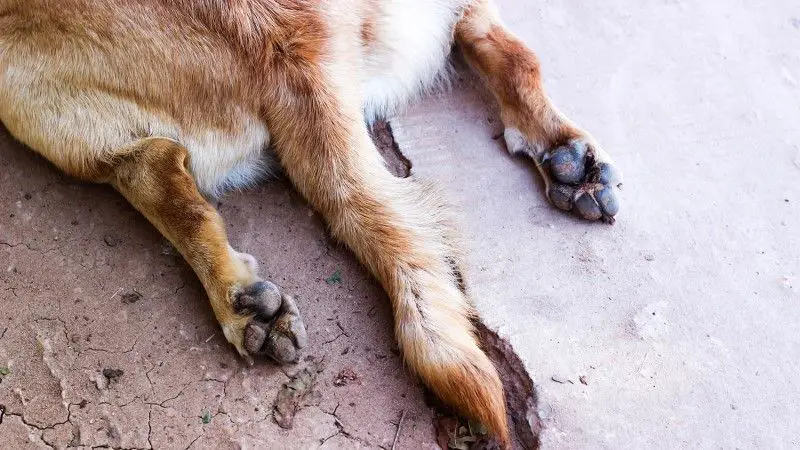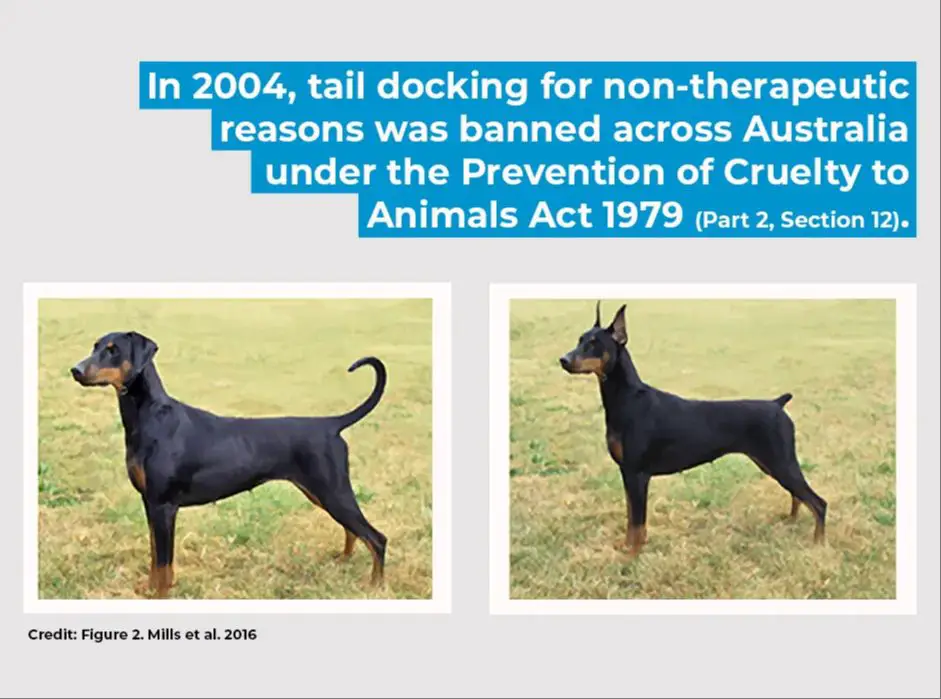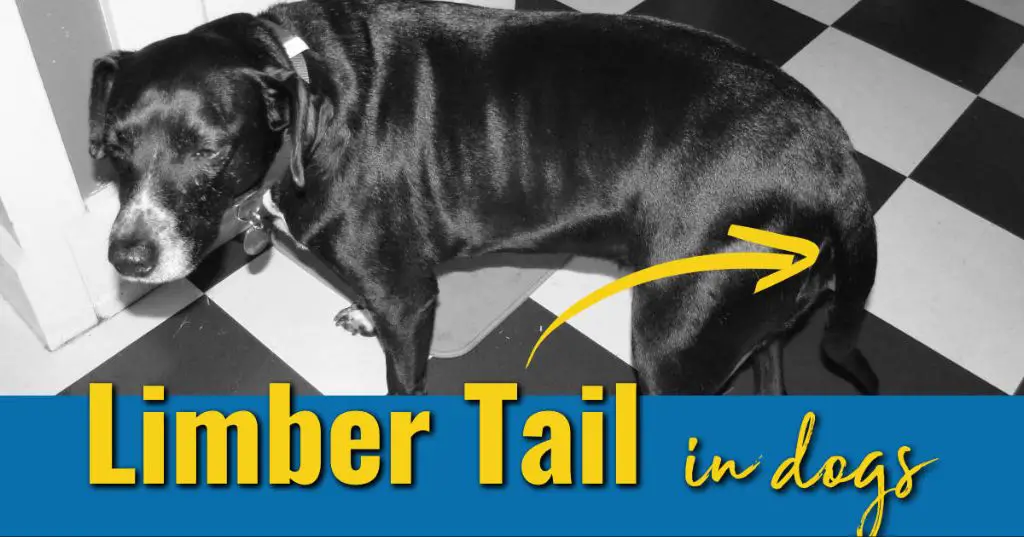Anatomy of a Dog’s Tail

A dog’s tail contains vertebrae, muscles, nerves, blood vessels and cartilage or bone. The main purpose of a dog’s tail is for communication and balance.
There are several bones that make up the tail. The tail begins with a continuation of the vertebrae from the spine. There are usually between 3-23 tail vertebrae depending on the dog breed. The bones provide structure, support and flexibility. Cartilage cushions the spaces between the vertebrae.
Muscles, tendons and ligaments hold the tail bones together and allow the tail to move in different directions. Pairs of muscles run vertically on either side of the vertebrae. Additional muscles move the tail from side to side horizontally. There are also blood vessels and nerves present to supply the tail with blood and sensations.
The shape and movement of the tail serves an important purpose for communication between dogs and people. The position and wagging of the tail indicates the dog’s mood and provides visual signals. A straight, upright tail often signals attention or excitement, while a lowered tail may indicate fear or uncertainty. Wagging can convey friendliness and happiness.
In addition to communication, the tail acts as a counterbalance when dogs run and make sudden movements. The tail helps dogs with balance, agility and coordination.
Breed Differences in Tail Bones
A dog’s tail is made up of bones, cartilage, muscles, tendons, nerves, and skin. The specific bones that make up a dog’s tail can vary between breeds.
Breeds like Greyhounds, Whippets, and Basenjis tend to have long, slender tails supported by rigid vertebrae bones that run most of the tail’s length. These types of tails don’t curl or bend easily since they contain more bones.
Other breeds like pugs, bulldogs, and corgis have naturally shorter and curlier tails due to having fewer tail vertebrae bones. Their tails are more flexible and able to curl since they have more cartilage between the shortened tail bones.
Herding breeds like the Australian Shepherd and Pembroke Welsh Corgi typically have their tails docked or partially removed shortly after birth. This is done for hygienic purposes and to avoid tail injuries while herding. Their natural tail shape varies depending on the breed.
In general, larger dog breeds tend to have longer, more rigid bony tails, while smaller dogs often have more cartilage and flexibility in their tails. The number of tail bones differs, affecting the tail’s ability to curl and move.
Injuries to the Tail Bone

A dog’s tail bones and nerves can be injured in a variety of ways. Some common causes of tail injuries in dogs include:
- Getting the tail shut in a door or window
- Having the tail stepped on
- Excessive tail wagging against hard objects
- Falling or trauma directly to the tail
- Animal bites from other dogs or animals
Symptoms of a tail bone injury typically include:
- Swelling of the tail
- Bruising around the tail base
- Bleeding from the tip of the tail
- Lacerations on the tail
- Pain when moving or touching the tail
- Loss of control over the tail
- Inability to lift or wag the tail
- The tail hangs limply
If your dog experiences any of these symptoms, it’s important to have a veterinarian examine the tail to check for fractures or other damage. Leaving tail injuries untreated can lead to permanent nerve damage or ongoing pain.
Treatment for Tail Injuries
If your dog injures its tail, the main treatments focus on rest, pain relief, and surgery if needed. Here are the typical steps for treating tail injuries:
Rest and Pain Medication
Just like humans, dogs need rest to heal from injuries. Restrict your dog’s activity by keeping them calm and confined. Try to limit stairs, jumping, and vigorous play. Providing a soft bed can make resting more comfortable. Over-the-counter pain medications like acetaminophen (Tylenol) or NSAIDs can help relieve pain and inflammation. Always consult your vet on proper dosage for your dog’s size and weight.
Surgery
If your dog’s tail injury involves broken bones, dislocations, hematomas, or other major trauma, surgery may be necessary. Procedures can include amputation of part of the tail, insertion of pins and rods, drainage tubes, or other techniques depending on the injury. Veterinary surgeons receive special training to properly repair tail injuries.
Recovery Process
Expect a recovery period of several weeks after surgery or significant injury. E-collars, bandages, and monitoring for complications will be needed. Physical therapy exercises may help improve range of motion and strength once healing begins. Be patient through the recovery process and follow all recheck and care instructions from your veterinarian. With proper treatment, most dogs can heal fully from tail injuries.
Preventing Tail Injuries
There are several precautions dog owners can take to help prevent injuries to their dog’s tail:
Be Careful Around Doors and Car Doors: Dog tails can easily get caught and slammed in doors, including car doors. Pay attention when opening and closing doors, and teach children to be careful as well. Install pet gates to keep dogs away from doors when they are being opened and closed.
Don’t Pull on the Tail: Never pull on your dog’s tail, and teach children not to as well. Pulling on the tail can lead to painful injuries.
Provide Mental Stimulation: Dogs that are bored may start chasing or biting their own tails, leading to injury. Make sure your dog gets plenty of exercise and mental stimulation through play time, training, puzzle toys and more.
Use Soft Surfaces: Place soft bedding and blankets in your home so your dog has cushioned areas to lay and sit. This can help prevent impact injuries to the tail.
Monitor for Signs of Injury: Check your dog’s tail regularly for any signs of injury, and take them to the vet promptly if you notice swelling, cuts, bleeding or changes in behavior when the tail is handled.
Docking Dog Tails
Tail docking is the practice of surgically shortening a dog’s tail. Historically, tail docking was done for functional purposes in working dogs like hunting dogs and herding dogs. The purpose was to prevent injury as the dogs did their jobs. For example, tail docking could prevent tail injuries in a hunting dog from getting caught in brush while chasing prey. Herding dogs could avoid tail injuries from livestock stepping on the tail.

In more modern times, tail docking is done primarily for cosmetic reasons to meet breed standards. Many breeds like Boxers, Corgis, and Dobermans have docked tails. For these breeds, a full tail is considered a fault for show dogs.
Tail docking has become controversial in recent years. Critics view it as an unnecessary cosmetic surgery done solely for appearance with no medical benefit to the dogs. They argue it can cause unnecessary pain and complications. Proponents say it can protect working dogs from injuries. For show dogs, they believe adherence to breed standards maintains the breeds’ distinctive appearances.
Arguments against docking include:
- – It provides no medical benefit for non-working dogs
- – Risks pain, infection and other complications
- – Alters dogs’ communication and expression
- – Performed for cosmetic reasons only
Arguments in favor include:
- – Maintains breed standards and distinctive look
- – Less risk when done properly by a vet on young puppies
- – Working dogs benefit from reduced tail injuries
- – Breeders and owners should have the choice
Overall, the debate continues around docking dog tails. More regions are starting to ban the practice unless medically necessary. But many breed enthusiasts argue it should remain an option, especially for working dogs prone to tail injuries. There are good arguments on both sides, and perspectives vary based on the context and purpose.
Happy Tail Syndrome
Happy tail syndrome, also known as acute tail trauma, is a common injury seen in dogs that wag their tails vigorously. It occurs when a dog wags its tail repeatedly against hard objects, causing the tip of the tail to split open and bleed. If left untreated, happy tail can lead to infection or other complications.
Certain breeds of dogs are more prone to happy tail due to the shape and thickness of their tails. These include Labrador retrievers, Great Danes, Pitbulls, and other large, strong breeds with long, thin tails. Dogs that live in confined spaces like apartments are also at higher risk since they have less room to safely wag their tails.
To treat happy tail, the tail tip is bandaged to protect it while it heals. Anti-inflammatory medication may be prescribed to reduce pain and swelling. In severe cases, or if the tail keeps re-opening, surgery may be needed to shorten the tail or close the wound. Prevention involves padding hard surfaces that a dog may hit while wagging, and monitoring their tail closely for any signs of injury. With proper treatment, most cases of happy tail resolve within 2-3 weeks.
Limber Tail Syndrome

Limber tail syndrome, also known as cold water tail or swimmer’s tail, is a condition that affects some dog breeds. It causes temporary paralysis and pain in the tail.
It occurs when the muscles that control the tail become swollen or injured, causing the tail to go limp. Certain dog breeds with long, thin tails like Labrador Retrievers and English Pointers are more prone to limber tail syndrome.
The exact causes are unknown, but it often happens when a dog swims in cold water, over-wags its tail, or injures its tail. The symptoms include a limp, drooping tail, swelling at the base of the tail, pain, and inability to wag the tail.
To treat limber tail, the tail must be allowed to rest. Anti-inflammatory medications can help reduce swelling and pain. Warm compresses, massages, and restricted activity may also help. More severe cases may require steroids or pain medication prescribed by a vet.
Most dogs recover fully in 1-2 weeks with rest and medication. Prevention involves avoiding over-exertion of the tail and exposure to cold water temperatures.
Caring for an Injured Tail
If your dog injures its tail, proper aftercare is crucial for healing. Here are some tips for caring for an injured tail at home:
Keeping the tail clean and dry: Gently clean the injured tail with a damp cloth and pat dry. Avoid getting the bandage wet. Change bandages regularly to prevent infection.
Using pain medication properly: Follow your veterinarian’s instructions for administering pain medication. Give prescription medication only as directed and monitor your dog for side effects.
Restricting activity: Limit your dog’s activity while the tail heals. Take short, gentle walks and avoid playing, running, or jumping. Prevent your dog from wagging or hitting the injured tail on objects.
Monitor your dog’s tail closely over the healing process. See your veterinarian if you notice increased swelling, bleeding, or signs of infection. With proper care, most tail injuries will heal within 2-3 weeks.
When to See a Vet
If your dog injures its tail, it’s important to monitor for signs that may require veterinary attention. Here are some situations when you should take your dog to the vet:
-
If the injury causes limping or obvious pain. Any signs of discomfort, trouble sitting or moving, or changes in behavior could indicate a more serious injury requiring professional treatment.
-
If the tail won’t stop bleeding. Minor cuts may bleed some, but persistent bleeding or large amounts of blood loss need medical care.
-
Signs of infection. These include swelling, redness, heat, pus, or a bad smell around the injured tail. Infections need antibiotics and treatment.
It’s always better to be safe than sorry when it comes to your dog’s tail injuries. Your vet can properly assess the damage, provide pain management, and treat any complications. Prompt veterinary care gives your dog the best chance at healing and preventing any long-term issues with their tail.